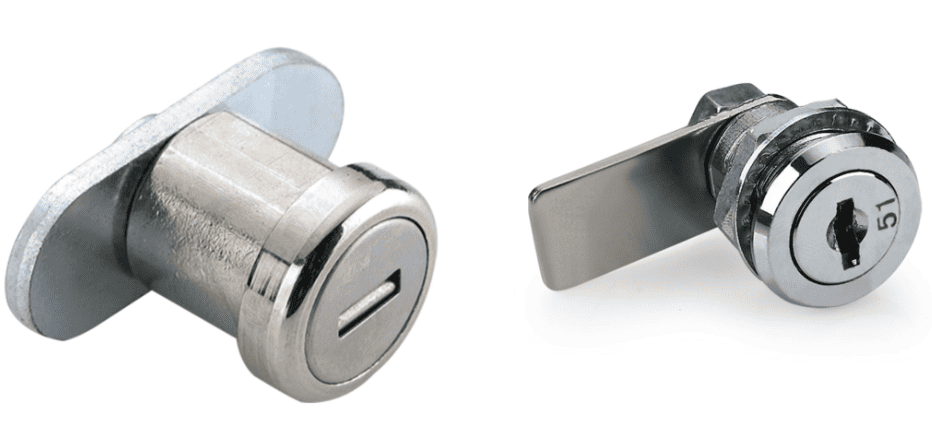When it comes to securing cabinets, lockers, and various types of enclosures, there are multiple options available. While traditional padlocks have been a common choice for decades, many individuals and businesses now prefer cam locks. Cam locks offer an effective combination of security, convenience, and aesthetic appeal. Unlike padlocks, which often protrude from the surface of the enclosure, cam locks are typically installed internally, offering a cleaner, more discreet look while still providing reliable protection. But what exactly are cam locks, and why are they increasingly favored in residential, commercial, and industrial settings?
At their core, cam locks are compact locking mechanisms designed to secure doors, drawers, cabinets, and other types of enclosures. The design is simple yet highly functional. A standard cam lock consists of two primary components:
Cylindrical Body or Keyed Nut: This is the part of the lock that houses the key mechanism. It fits flush with the front of the enclosure, giving a sleek, unobtrusive appearance.
Tongue Bar or Cam: Attached to the back of the cylindrical body, the cam is a flat or angled metal piece that rotates when the key is turned. Its movement either secures or releases the enclosure, depending on its orientation.
When installed correctly, cam locks provide reliable locking with minimal space requirements. This makes them particularly suitable for furniture, lockers, cabinets, and other confined spaces where a protruding padlock might be inconvenient or unsightly.

Cam locks operate on a straightforward mechanical principle. The cylindrical body houses the key mechanism, while the cam acts as a lever to engage or disengage the lock. When a key is inserted and turned, the cam rotates either horizontally or vertically.
Locking: In the locked position, the cam extends into a slot or behind a panel inside the enclosure, preventing it from being opened.
Unlocking: In the unlocked position, the cam retracts or rotates to a neutral orientation, allowing the door, drawer, or cabinet to open freely.
The simplicity of the design belies its effectiveness. Because the cam is hidden behind the enclosure, tampering is much more difficult than with external locks, adding an extra layer of security.
Cam locks come in a variety of types, including tubular cam locks, cam locks with combination dials, and high-security versions with anti-drill or anti-pick features. Despite these variations, the fundamental working principle remains consistent: the rotation of a cam controlled by a key or combination secures the enclosure.
When selecting a cam lock, several factors should be considered to ensure optimal security and durability.
Cam locks are manufactured from a range of materials, each offering different levels of strength and resistance. Zinc alloy is one of the most common materials, valued for its durability, corrosion resistance, and cost-effectiveness. Zinc alloy is a metallic mixture that includes zinc and at least one other metal, such as copper. Brass is another popular choice, often praised for its aesthetic appeal, corrosion resistance, and longevity. Stainless steel cam locks provide the highest durability and are suitable for environments prone to moisture or harsh conditions.
Cam locks are available in different lengths, diameters, and cam shapes. The correct size ensures proper fit and optimal locking performance. Consider the thickness of the door or drawer panel and the space available for cam rotation.
Some cam locks offer basic security suitable for office furniture or personal storage. Others are designed for higher-security applications, such as safes, vending machines, or sensitive equipment. High-security cam locks may include features like anti-drill plates, reinforced cams, or complex keyways that resist duplication.
Cam locks may be operated using traditional keys, tubular keys, or combination codes. In commercial settings, keyed cam locks are often preferred for controlled access, whereas combination cam locks offer convenience and eliminate the need for key management.
Cam locks are versatile and used across a wide spectrum of applications. Their concealed design, ease of installation, and functional reliability make them a popular choice in both residential and commercial contexts.
One of the most common uses for cam locks is in office desks, filing cabinets, and storage drawers. Organizations often use cam locks to secure sensitive documents, office supplies, or company assets. By restricting access to authorized personnel only, cam locks help prevent theft and unauthorized access.
Cam locks are widely used in vending machines to secure the cash compartment and product storage areas. The lock prevents tampering and ensures that only authorized personnel can access the machine’s contents.
Many safes, lockboxes, and small security cabinets feature cam locks as an additional layer of protection. They can secure items such as cash, jewelry, keys, or confidential documents.
Cam locks are not limited to offices and commercial spaces. Many homeowners use them to secure mailboxes, lockers, storage cabinets, and even key lockboxes. A cam lock can protect valuables or provide controlled access to shared spaces.
For smaller-scale applications, cam locks can be installed on file folders, portable storage containers, or specialized equipment cases. This allows individuals or organizations to safeguard sensitive or personal items conveniently.
Like any mechanical device, cam locks require routine maintenance to ensure long-term performance. Regular maintenance can prevent issues such as sticking keys, difficulty turning the lock, or wear that compromises security.
Dust and debris can accumulate inside the lock mechanism, causing it to jam. Periodically clean the lock and key using a soft cloth or compressed air to remove any buildup. Avoid harsh chemicals that might damage the material.
Some cam locks benefit from occasional lubrication. Use a manufacturer-recommended lubricant to maintain smooth operation. Avoid excessive lubrication, which can attract dust and lead to gumming of the mechanism.
Periodically inspect the cam lock for signs of wear, rust, or tampering. If the lock shows any damage or difficulty operating, it should be repaired or replaced promptly to maintain security.
For high-security applications, or if the cam lock is malfunctioning, consider consulting a professional locksmith or the manufacturer. Attempting to repair a sophisticated cam lock without expertise may damage the mechanism or void warranties.
The effectiveness of cam locks depends not only on the quality of the lock itself but also on how keys are managed. Proper key management ensures that only authorized individuals have access to the secured items.
Secure Storage: Keep spare keys in a secure location, such as a locked drawer or key safe. Avoid leaving keys in unsecured areas where they could be easily copied or lost.
Access Control: Limit access to keys based on necessity. Only personnel who require access should be given a key.
Unique Keys: Consider assigning unique keys to different individuals or departments to track access. This can be particularly useful in office environments or commercial facilities.
Key Tracking Systems: For larger organizations, key tracking systems can be used to monitor who has accessed the cam lock and when, adding a layer of accountability.
While cam locks provide effective basic security, they should often be used in conjunction with additional protective measures for high-value or sensitive assets. Combining cam locks with other security systems can provide comprehensive protection.
Installing cameras near areas with cam-locked enclosures deters theft and allows monitoring of access. Visual evidence can also be valuable in case of disputes or security incidents.
Some facilities integrate cam locks with electronic access systems. While traditional cam locks are manually operated, certain modern designs can work with electronic control panels to restrict access digitally.
Adding alarms or sensors to cabinet doors can alert personnel if unauthorized access is attempted. This is particularly useful for high-risk environments, such as laboratories, retail backrooms, or warehouses.
For maximum protection, use cam locks as part of a layered security strategy that includes structural security (reinforced doors, secure enclosures), electronic security (alarms, cameras), and procedural security (restricted access, monitoring).
Cam locks have grown in popularity because they offer several distinct advantages over traditional locking solutions:
Unlike padlocks that protrude, cam locks sit flush with the surface of the enclosure, offering a clean, professional look.
Cam locks are simple to install and can often be retrofitted to existing cabinets or drawers with minimal effort.
Cam locks come in various sizes, materials, and operating mechanisms, making them suitable for a wide range of applications.
High-quality cam locks provide reliable security at a relatively low cost, making them accessible for both personal and business use.
The internal placement of the cam reduces the risk of tampering or forced entry compared to external padlocks.
Cam locks are an elegant, practical, and secure solution for protecting cabinets, lockers, drawers, and other enclosures. Their internal design, ease of use, and versatility make them a preferred choice for homes, offices, and commercial environments alike. By understanding the different types of cam locks, their materials, applications, and proper maintenance, users can ensure that their assets remain secure and accessible only to authorized individuals.
Whether you are securing office files, safeguarding a vending machine, or protecting valuables at home, cam locks offer a reliable, unobtrusive solution. When combined with good key management, regular maintenance, and additional security measures, they form an essential part of any comprehensive security strategy.
Investing in high-quality cam locks and following best practices for use and upkeep ensures peace of mind and a higher level of protection for both personal and professional property. As security concerns continue to evolve, cam locks remain a timeless and practical tool, blending simplicity, efficiency, and reliability.
